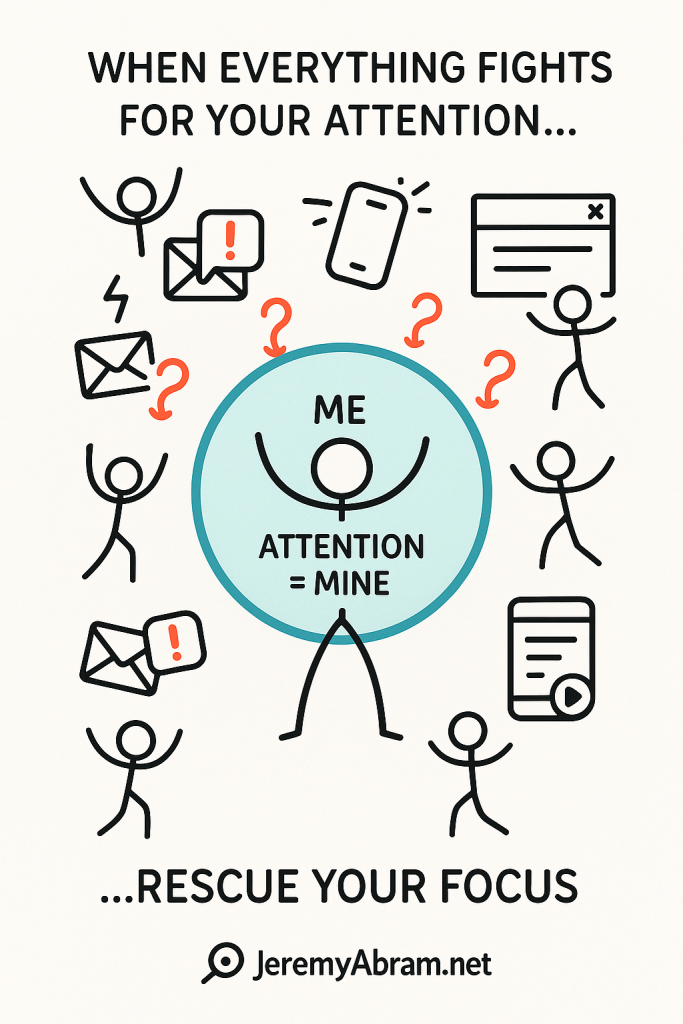
by Jeremy Abram | JeremyAbram.net
I. The Crisis of the Modern Mind
Every day, billions of digital interruptions compete for the same scarce resource: your attention. Notifications, pings, pop-ups, promotional emails, algorithmic nudges, and “urgent” reminders all share one unspoken agenda — to fracture your focus. The average person now switches tasks more than 1,000 times per day, according to recent behavioral analytics from RescueTime and similar tools. The result is a kind of low-grade cognitive chaos — not full-blown distraction, but a constant hum of divided awareness.
Spam, once confined to shady email offers and fake princes with offshore fortunes, has evolved into something larger: a cultural architecture of interruption. It’s no longer just about unwanted messages — it’s about a system that thrives on keeping you perpetually reactive.
II. Spam as the DNA of the Attention Economy
The modern internet was built on engagement metrics. Every click, view, and scroll is a microtransaction of attention. Advertisers pay for impressions; platforms optimize for retention. And spam — in its many forms — is the dark mirror of this model.
Traditional spam floods your inbox.
Algorithmic spam floods your feed.
Psychological spam floods your thoughts.
Each is designed to provoke the same outcome: response. Whether you delete it, click it, or rage about it on social media, your engagement still counts. Spam survives because the system rewards it. The attention economy — powered by adtech and data brokerage — doesn’t care about what holds your focus, only that it does.
The boundaries between “content” and “spam” have blurred. Click-bait news, autoplay videos, push notifications, even some AI-generated posts — they all operate on the same incentive structure. In this sense, the attention economy is not merely infested with spam; it produces it by design.
III. The Cognitive Cost of Constant Interruption
Neurologically, the human brain was never meant to multitask across dozens of stimuli per minute. Studies in cognitive psychology consistently show that attention residue — the mental “lag” between switching tasks — can reduce productivity by up to 40%. The more fragmented your focus becomes, the harder it is to sustain deep work, reflection, or even memory consolidation.
Spam contributes to this degradation not just through volume, but through unpredictability. Every ping creates a micro-burst of dopamine, followed by a drop. Over time, this trains the brain to seek interruption. The result: an attention system addicted to novelty, incapable of stillness.
In a spam-driven world, silence feels unnatural — even threatening.
IV. Data, Profit, and the Monetization of Distraction
Behind every spam message lies a business model. Whether it’s an adtech network, affiliate funnel, or AI-curated engagement loop, the goal is to transform human focus into measurable currency. The more fragmented your attention, the more opportunities there are to sell micro-moments of your consciousness.
Consider this: a typical smartphone user receives 45 to 80 push notifications daily. Each represents an attempt — however small — to reroute your time. Multiply that across billions of users, and the global attention market becomes one of the largest economies in history, measured not in dollars, but in seconds.
In this model, your distraction is the product. The spammer is simply the entrepreneur who learned to exploit it most efficiently.
V. The Subtle Forms of Modern Spam
The evolution of spam isn’t just technological; it’s psychological. Here are its newest disguises:
- Notification Spam: Retail apps and social networks now send “personalized” updates crafted to simulate relevance — the digital equivalent of junk mail with your name printed on it.
- Algorithmic Echoes: Feeds that recycle the same content themes to maintain engagement, masquerading as “recommendations.”
- AI Noise: Auto-generated comments, reviews, and posts created to fill the digital void with endless “activity.”
- Influencer Spam: Paid placements disguised as authenticity — micro-advertisements in the voice of a friend.
Each is a layer in the evolving spam ecosystem — less about malware and more about mindware.
VI. Rescuing Attention: The New Digital Minimalism
Reclaiming focus isn’t about retreating from technology; it’s about re-engineering your relationship with it. Digital attention rescue means designing boundaries that honor your cognitive bandwidth.
Here are actionable strategies grounded in behavioral research:
- Implement “notification fasting.” Silence all non-essential alerts for 24 hours. The resulting mental clarity often feels physical.
- Reclaim the inbox. Use filters, rules, and bulk unsubscribes to reduce incoming noise. Treat your inbox like a garden, not a landfill.
- Adopt single-tasking rituals. Time-block deep work sessions where only one window — literally and mentally — remains open.
- Audit your attention footprint. Use analytics tools to track how your time is distributed. Awareness precedes control.
- Curate your inputs. Replace algorithmic feeds with deliberate sources — newsletters, RSS, or print — that you choose to engage with.
The goal isn’t digital abstinence. It’s sovereignty.
VII. Beyond Detox: Building the “Attention Commons”
If attention is the new oil, then we must treat it as a shared natural resource. Every spam message, every manipulative notification, every auto-playing ad erodes the collective quality of consciousness. Rescuing attention isn’t just personal — it’s societal.
What would it look like if platforms were penalized for wasting human attention instead of rewarded for capturing it? If design ethics favored restoration over retention? If governments recognized “cognitive pollution” as a public-health issue?
We’re entering that debate now. The attention economy has reached its saturation point. The next frontier is what comes after it — a world where focus is protected, not mined.
VIII. The Rescue Mission Begins
Digital attention rescue is not about deleting your apps or escaping the web; it’s about defending the most valuable asset you still own — your awareness. The world will not stop sending spam. But you can stop letting it rent space in your head.
To reclaim focus in a spam-driven world is to reclaim authorship of your own mind.
And that may be the most radical act of all.
Leave a Reply